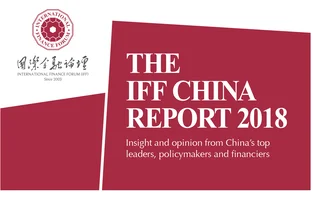
A new insurance industry – Protecting the BRI’s interests
Political, legal and economic risks proliferate in the developing countries along the route of the Belt and Road Initiative, and China is building a modern, dynamic insurance industry to serve and actively respond to the risk protection, economic and social development needs in the region, explains Zhou Yanli, IFF vice-chairman and former vice‑chairman of the China Insurance Regulatory Commission


The Belt and Road Initiative (BRI) is a win-win solution for participating countries as they work together to achieve greater development, though this is not without risk. The modern insurance industry has its origins in the booming maritime trade, and the history of marine insurance is evident in the history of the global flow of goods and capital in the great navigation era. The developments of the insurance industry and advancements in insurance technology have provided strong support for globalisation over the past century. Opinions of the State Council on accelerating the development of modern insurance industry 1 confirmed the importance of insurance as a modern Chinese industry and a fundamental means of risk management.
By serving the BRI, the insurance industry meets the inevitable demands on it to serve national strategy and the real economy. The insurance industry must also adapt to the new situation of China’s ‘opening‑up’ to the outside world, and better serve the real economy. At this critical moment, the insurance industry must seize its opportunity and make the best of its strengths – financial support, risk management, credit management and regulatory systems – to achieve global development while providing an array of risk guarantees and financing services to invigorate the BRI’s development. History has endowed a major responsibility to the insurance industry.

This article describes the significance of the BRI and analyses the risks it faces, the demands on insurance in the BRI, the development of the insurance industries in countries along the route and how the insurance industry serves the BRI. The direction in which the insurance industry must travel and the measures it must take to serve the BRI are also explored.
An inevitable choice for China’s economic development
An initiative for development, co-operation and openness, the BRI has inherited the traditions of the ancient Silk Route. It is a ‘bridge’ connecting Asia with Europe and Africa, in line with the requirements of the times and the desires of all countries to accelerate development. Through emphasising the principles of extensive consultation, joint contribution and shared benefits, it aims to pursue equally the connectivity of policy, infrastructure, trade, capital and people. Through various forms of co-operation, the BRI is committed to boosting contacts and exchanges between China and other countries along the route, and promoting strategic partnerships for regional economies to reap win-win rewards. The implementation of the BRI is conducive to China’s opening‑up to the outside world, advancing China’s economic transformation, ensuring the security of the strategic gateway and expanding China’s international influence. Meanwhile, it can drive the economic development of countries along the route and boost global economic recovery through peace and stability.
Facing an array of risks
More than 100 countries and international organisations are currently participating in the BRI, of which more than 40 have signed co-operation agreements with China. Many major projects have been put in place and unexpected additional progress and achievements have been made in the fields of infrastructure, project co-operation, trade and investment. However, countries along the BRI are primarily emerging markets and underdeveloped countries, often with weak economic bases, volatile political situations and ethnic conflicts. The BRI is expected to face the risk of default as well as political, economic and legal risks, which pose severe challenges to the BRI currently and will continue to do so in the future. Political risk includes geopolitical risk – action taken by major powers and regime changes; economic risk is mainly triggered by the fragility of the investment environment, the international market environment and enterprises’ capabilities for international operation; and legal risk includes risks being subject to the laws and regulations of the host country and the challenges of negotiating with host governments or enterprises.
By serving the BRI, the insurance industry meets the inevitable demands on it to serve national strategy and the real economy
Insurance needs
The centrality of risk management differentiates the insurance industry from other financial industries. As a market-based risk management and financing mechanism, the insurance industry has accelerated the development of overseas investment insurance and other insurance businesses based on the requirements of the BRI. It has given full play to its role in loss reimbursement. The insurance industry has actively responded to the special risk protection needs in building core areas and node cities, and to the risks facing China’s overseas personnel, property and investment, so as to provide comprehensive insurance coverage for the BRI. For example, in terms of property risk protection, customised insurance products and services – such as insurance covering engineering, fire, cargo transportation, transport facilities, liability and export credit – can provide property risk protections, allowing Chinese enterprises to ‘Go Out’.
Meanwhile, in terms of personal risk protection, insurance for accidental worker injury and pensions for low-income, non-landowning individuals is highly suited to protecting workers constructing the BRI. In providing financial support, we can give full rein to large‑scale, long-term and highly stable insurance funds and participate in the BRI through debt financing, equity investment, private equity funds, asset-backed plans and other ways under the premise of ‘compliance with laws and regulations with controllable risks’.
Insurance development in BRI countries
The insurance industry has maintained steady growth against the backdrop of the global economic slowdown. The BRI involves 65 countries and regions from China through to central and eastern Europe. The quality of insurance markets in countries along the BRI is generally below the global average, and the depth and breadth of insurance coverage is relatively small. Yet the inauguration of the BRI in 2013 led to international insurance institutions becoming more active in the area through building global insurance service networks and creating customised products and services. More recently, China’s insurance industry has also made remarkable achievements, greatly enhancing the capacity in serving economic and social development, expanding the scope of economic and social security, and improving its ability in infrastructure construction, positioning it well to deliver for the BRI.
China’s insurance industry has emancipated its attitude and has boldly explored new ways of operating. On the one hand, it has promoted overall development while making the BRI’s top-level design a success and, on the other, it has taken the initiative to connect risk protection and financing, innovate products and services, and make good progress in serving the BRI.
Most importantly, it has provided financial support. The China Insurance Regulatory Commission has accelerated market-based reform of insurance funds, reduced pre-approvals, relaxed restrictions on investment ratios, enriched investment forms and supported the participation of insurance funds to the BRI.
In addition, it has improved insurance services. The insurance industry tailors insurance solutions to the pattern of overseas investment projects and export contracts. It strengthens co-operation with banks to provide enterprises with value-added services such as information consultation and financing design, which enhances bidding advantages and investment and financing capabilities of enterprises to make large-scale exports of complete sets of equipment, overseas investment and overseas project contracting.
Finally, the insurance industry has reinforced collaborative work on supervision. It has boosted bilateral and multilateral insurance regulation co-operation in Asia and enhanced the regional influence of China’s insurance regulation so as to better promote the late-mover advantage in emerging markets.
A new direction
The insurance industry should fully understand the importance of participating in and serving the BRI – enhancing its sense of responsibility – formulate effective development strategies and establish a long-term service mechanism. It must co-ordinate with the national strategy and be proactive in top-level design, product and service innovation, insurance investment, co-operation mechanism, and risk management and control, and protect the implementation of the BRI.
The insurance industry needs, foremost, to make co-ordinated efforts to ensure its top-level design serves the BRI. It must create more innovative products and services, it should explore new ways of directing funds, it must establish a co-operation mechanism, and it must enhance risk management and control for insurance in supporting the BRI.
Only users who have a paid subscription or are part of a corporate subscription are able to print or copy content.
To access these options, along with all other subscription benefits, please contact info@centralbanking.com or view our subscription options here: subscriptions.centralbanking.com/subscribe
You are currently unable to print this content. Please contact info@centralbanking.com to find out more.
You are currently unable to copy this content. Please contact info@centralbanking.com to find out more.
Copyright Infopro Digital Limited. All rights reserved.
As outlined in our terms and conditions, https://www.infopro-digital.com/terms-and-conditions/subscriptions/ (point 2.4), printing is limited to a single copy.
If you would like to purchase additional rights please email info@centralbanking.com test test test
Copyright Infopro Digital Limited. All rights reserved.
You may share this content using our article tools. As outlined in our terms and conditions, https://www.infopro-digital.com/terms-and-conditions/subscriptions/ (clause 2.4), an Authorised User may only make one copy of the materials for their own personal use. You must also comply with the restrictions in clause 2.5.
If you would like to purchase additional rights please email info@centralbanking.com test test test







